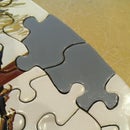Introduction: Miniature Sculpture Replicas
About ten years ago, I had the opportunity to take a five-day class in stone carving or more specifically, garden sculpture. I love it. Since then, I have repeated the class and set up an area in the backyard for stone carving. Garden sculpture is great, but you can't exactly set it on the window sill or use it to decorate a desk. However, we a little help from computer software and a 3D printer, it isn't hard to make beautiful little copies.
Supplies
- A sculpture to copy, or any other object that you want to clone.
- A camera, a phone camera is fine.
- A computer
- A Photogrammetry program. Free Open Source programs are available.
- A program to edit 3D objects defined by a "mesh." Free Open Source programs are available.
- A 3d printer or access to a 3D printer or use of an online 3D printing service.
Step 1: Acquire an Object to Copy
Find or create the object that you would like to copy. This process will work with any object that you can move around freely and take pictures from all angles. It could be a sculpture that you already have or something you buy. But what fun is that? Why not be a double maker and create the thing you want to copy and then make the copy?
Here are just a few of the pictures of the process of carving this sculpture from Indiana limestone. I use a hammer and chisel, avoiding power tools, which I think detract from the meditative nature of stone carving. My instructor calls it "Rhythms of Stone."
By the way, this is the piece I created in my first class. You never know what you can do until you try!
Step 2: Acquire Photogrammetry Sofware
I use the program Meshroom, which is available for Windows and Linux. There are also programs available for the Mac.
Photogrammetry is the art, science, and technology of obtaining information about physical objects through processes of recording, measuring, and interpreting photographic images. In other words, when there is sufficient information about an object provided by a collection of photographs, computer algorithms can determine precise measurements and create a model of the object.
Step 3: Photograph the Object and Compute the Model
Here is just a small sampling of the photos I took to create this model. It is important to move all the way around the object in steps of about 15 or 20 degrees and from above, from the middle area, and from below. Any features that don't appear in multiple photos from multiple angles won't be reliably reproduced. It seems like a good number for these small stone sculptures is around 50 pictures.
Step 4: Clean Up the Model
The photogrammetry software calculates the position of the camera (first figure) from each of the photographs and then plots points that build up the surface of the object. The points are then converted to a surface made up of many, many small polygons (second figure). This is called a mesh.
An additional program, I use Meshlab, can then be used to trim away the surrounding terrain, leaving just the desired object as a stand-alone model. By the way, when taking pictures, you should move around the object with the camera rather than rotating the object. That is because the surrounding terrain will be used by the algorithm to match up the views. You can see in the second figure that the yard around the sculpture was captured, and this is what we want to trim away using Meshlab or any other mesh editing software.
Step 5: 3D Print the Model
This particular model was tall and thin and so there was a risk that it would fall over during printing. All slicer programs (the programs that prepare 3D prints for the printer) provide options for stabilizing the print with what is called a skirt. I chose to add a few small triangles of support that just barely touched the model. They add support during printing and are easily broken off after printing. See figures above.
Step 6: Decorate If Desired
This model was painted to look like stone for a more finished look.











